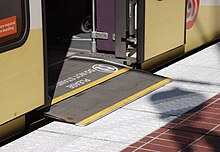mdrejhon
Senior Member
Here's a new PowerPoint presentation, 2012 about converting Bombardier BiLevels to level boarding.
Selected slides pictured.
This is what GO's Verster plans, I believe.
It's possible to have level boarding with Bombardier BiLevels, with only a 3-inch gap (no human-deploy ramp needed). While retaining 100% compatible with non-special freight train loads, using the following instructions. (Only Special Loads would be unable to use Platform 26/27/28/29).
(The Bombardier BiLevels were UTDC before Bombardier bought them)







Selected slides pictured.
This is what GO's Verster plans, I believe.
It's possible to have level boarding with Bombardier BiLevels, with only a 3-inch gap (no human-deploy ramp needed). While retaining 100% compatible with non-special freight train loads, using the following instructions. (Only Special Loads would be unable to use Platform 26/27/28/29).
(The Bombardier BiLevels were UTDC before Bombardier bought them)
Attachments
-
 upload_2018-2-11_17-43-1.png788.2 KB · Views: 1,209
upload_2018-2-11_17-43-1.png788.2 KB · Views: 1,209 -
 upload_2018-2-11_17-43-30.png1 MB · Views: 1,192
upload_2018-2-11_17-43-30.png1 MB · Views: 1,192 -
 upload_2018-2-11_17-44-4.png895.8 KB · Views: 1,209
upload_2018-2-11_17-44-4.png895.8 KB · Views: 1,209 -
 upload_2018-2-11_17-44-18.png797 KB · Views: 1,429
upload_2018-2-11_17-44-18.png797 KB · Views: 1,429 -
 upload_2018-2-11_17-45-0.png776.6 KB · Views: 1,950
upload_2018-2-11_17-45-0.png776.6 KB · Views: 1,950 -
 upload_2018-2-11_17-46-19.png1,005.8 KB · Views: 1,303
upload_2018-2-11_17-46-19.png1,005.8 KB · Views: 1,303 -
 upload_2018-2-11_17-46-55.png582.5 KB · Views: 1,192
upload_2018-2-11_17-46-55.png582.5 KB · Views: 1,192












